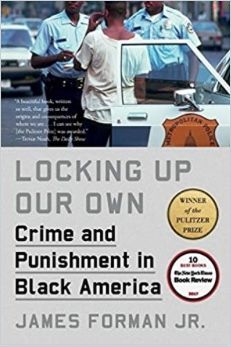Yale Law professor James Forman’s Pulitzer Prize-winning historical overview tracks America’s unequal treatment of Blacks under the law.

Unequal Under the Law
Yale Law School professor James Forman Jr., a former Washington, DC public defender, co-founded the District’s Maya Angelou Public Charter School. In broad strokes and in specific detail, his 2018 book provides an historical overview of the United States’ history of incarcerating Black Americans and the ever-growing American gulag. Forman points out that the United States has only 5% of the world’s population, but 25% of its prisoners.
Forman’s objective indictment of the US judicial system won the Pulitzer Prize for General Non-Fiction; The New York Times Book Review named it one of the 10 Best Books of the Year; and it was a finalist for the Los Angeles Times’ Book Prize. This groundbreaking, comprehensive work drew reviews on par with its prizes. The Wall Street Journal said Forman’s work “doesn’t play down the history of racism in our criminal justice system, but it does explain why racial bias doesn’t tell the whole story.” Bryan Stevenson, author of Just Mercy, said that Forman, “carefully exposes the complexities of crime, criminal justice and race. What he illuminates should not be ignored.”
Bellicose Policing
Forman says that the United States adopted more bellicose law enforcement in the 1970s, including harsher policing styles, longer prison sentences, mandatory minimum sentences and lifelong disenfranchisement for felons.
Mass incarceration is the result of small, distinct steps, each of whose significance becomes more apparent over time, and only when considered in light of later events. James Forman, Jr.
However, Forman notes, many African-American leaders and communities favored tough-on-crime policies. Starting in the 1960s, Black communities faced epidemics of violent crime. Forman details how Black and white leaders built this oppressive system piecemeal over decades – each component cropping up as a response to increasing drug addiction, gun proliferation and spiraling homicides.
War on Drugs
Forman indicts the war on drugs for wreaking havoc on African-American communities. Between 1968 and 1975, he notes, marijuana-related arrests in Washington, DC increased 900%. Forman offers the remarkable and seldom-reported insight that African-American approval of the war on drugs makes sense only against the backdrop of the heroin epidemic that devastated Black communities. Drug-fueled robberies, both armed and unarmed, Forman discloses, were the fastest-growing crime from the early 1960s to 1973.
Black Policing
Forman emphasizes that the first police forces in the South were formed to catch enslaved people who escaped and subsequently to enforce racist vagrancy laws and curfews. He quotes a 1936 report showing that white police officers in Atlanta cared little about Black-on-Black crime and abused Black citizens. The report, Forman laments, described a “dysfunctional relationship” he finds akin to today’s circumstances. In the 1950s and 1960s, Forman finds that Black citizens faced relentless abuse, beatings and shootings from white police.
Blacks wanted the right to serve as police officers just as badly as white supremacists wanted to deny it to them.James Forman Jr.
But, Forman points out, Black citizens complained that Black officers were as harsh and abusive as white ones. Often, Black cops felt shame about Black offenders and how they reflected on their community. Forman clarifies an historical anomaly: Black recruits didn’t join police forces just to promote civil rights; they signed up because policing offers stable, well-paid work. Forman posits that Black officers may have believed that making their neighborhoods safe required a tough-on-crime stance. He portrays Burtell Jefferson, who became DC’s first Black police chief in 1978, as a supporter of stiffer penalties, including mandatory minimum sentences.
In 1982, DC voters approved five-year minimum sentences for first offenders who committed a violent crime with a gun. Repeat offenders faced 10-year minimums. Forman explains that other cities followed, and Congress instituted federal mandatory minimums.
Crack
Forman blames crack cocaine for an unprecedentedly violent drug marketplace which led police departments to undertake military-style operations. Forman lists a few violent sweeps: Los Angeles had Operation Hammer, New York launched Operation TNT and Memphis unleashed Operation Invincible. Washington, DC’s Operation Clean Sweep, Forman recounts, gave police officers the authority to set up roadblocks, confiscate cars and condemn housing.
In 1995, Forman found, the New York Police Department adopted a stop-and-frisk policy against young men of color. Forman regards Operation Ceasefire – which enabled police to use minor infractions as pretexts to stop cars and search for guns – as a further erosion of civil rights.
Whites and Blacks use drugs at roughly the same rate, but, as Forman states repeatedly, Blacks are more likely to face arrest. And, he finds that state facilities imprison Blacks at five times the rate of whites.
Incarceration
Forman offers what may be a surprise: violent crime has sharply declined in the United States. For example, from 2000 to 2014, Forman reveals that drug-related killings plunged 83% in Washington, DC, and the national murder rate dropped below that of 1960.
Although officers recognize some segments of [a high-crime] community – the shopkeepers, the pastors, the elderly grandmothers – as law-abiding citizens, they regard most neighborhood residents, and young people in particular, with generalized suspicion.James Forman Jr.
A poignant question informs Forman’s outlook: what would happen if American society actually embraced equal protection under the law?
Comprehensive
Through rigorous research and heartfelt prose, Forman provides a catalog of events, statistics, historical moments and political policies that illuminate America’s history of arresting and incarcerating Blacks in greater percentages than whites. Those who maintain that systematic racism is not a factor in US history and contemporary society will either find inarguable evidence to the contrary or avoid Forman’s insights altogether. His measured, reasoned reporting makes this a memorable read. It might serve as a superb high school or college text and provide shocking new information even for readers already familiar with America’s civil rights history.
Related reading on race, crime and law enforcement in America includes Worse Than Slavery: Parchman Farm and the Ordeal of Jim Crow Justice by David M. Oshinsky; Punishment Without Crime: How Our Massive Misdemeanor System Traps the Innocent and Makes America More Unequal by Alexandra Natapoff; Just Mercy: A Story of Justice and Redemption by Bryan Stevenson; and The New Jim Crow: Mass Incarceration in the Age of Colorblindness by Michelle Alexander.







